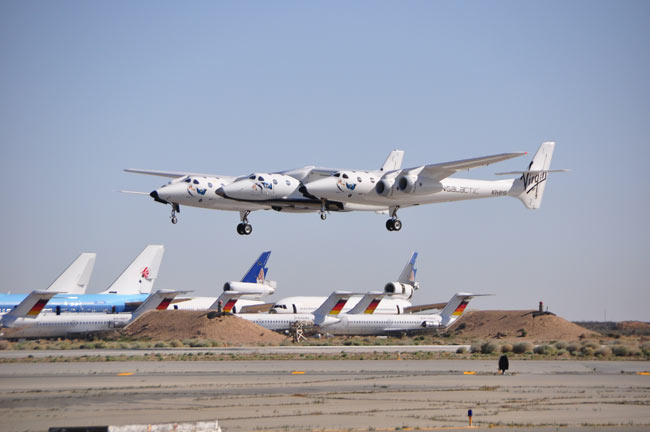Virgin Galactic Flies Passenger Spaceship and Mothership for First Time

This story was updated at 3:54 p.m. ET.
The future of public space travel spread its wings for the first time Monday at the Mojave Air and Space Port in California as Virgin Galactic's inaugural SpaceShipTwo suborbital spaceship took to the skies attached to its enormous mothership.
After rolling down a desert runway, the WhiteKnightTwo (WK2) carrier plane went aloft for the first time while carrying SpaceShipTwo (SS2) — the craft designed to eventually propel two pilots and six passengers to the edge of space.
The carrier plane and suborbital spaceship were built for British billionaire Sir Richard Branson's Virgin Galactic spaceliner fleet.
According to observers at the site, the aircraft-spaceship combo flew for roughly three hours. Conditions at Mojave for the test flight were described as being a beautiful day with a slight breeze [more photos of SpaceShipTwo's flight].
SpaceShipTwo is the prototype for the world's first commercial passenger spaceship, destined to take private astronauts into suborbital space and paving the way for space transportation.
Taking flight
The WK2/SS2 is a space launch system being built by the aerospace company Scaled Composites in Mojave. The company was founded in 1982 by aerospace designer, Burt Rutan, and also built the smaller SpaceShipOne suborbital craft that won the $10 million Ansari X Prize for reusable, manned suborbital spacecraft in 2004.
Get the Space.com Newsletter
Breaking space news, the latest updates on rocket launches, skywatching events and more!
Over the years, Scaled has accumulated broad experience in air vehicle design, tooling and manufacturing, specialty composite structure design, analysis and fabrication, and developmental flight tests of air and space vehicles.
The first SS2 sports the name Virgin Space Ship (VSS) Enterprise. The debut WhiteKnightTwo mothership is named Eve after Branson's mother.
"This is a momentous day for the Scaled and Virgin Teams," Rutan said in a statement after today's successful captive carry flight. "The captive carry flight signifies the start of what we believe will be extremely exciting and successful spaceship flight test program."
Many test flights ahead
Today's maiden voyage of SpaceShipTwo is to be followed by a number of test hops of the vehicle, eventually leading to drop tests, followed by the craft firing its hybrid rocket motor.
In the future, WK2 will carry SS2 to above 50,000 feet (16 km) before the spaceship is dropped and fires its hybrid rocket motor to launch into space from that altitude.
SpaceShipTwo was publicly unveiled last December. Throughout the year, an extensive step-by-step test program is planned, leading up to tourism flights from Spaceport America in New Mexico.
"Seeing the finished spaceship in December was a major day for us but watching VSS Enterprise fly for the first time really brings home what beautiful, ground-breaking vehicles Burt and his team have developed for us," Branson said in a statement. "It comes as no surprise that the flight went so well; the Scaled team is uniquely qualified to bring this important and incredible dream to reality. Today was another major step along that road and a testament to US engineering and innovation."
Speaking last month at a suborbital research workshop held in Boulder, Colo., Stephen Attenborough, commercial director for Virgin Galactic made clear that safety is the watchword of the undertaking.
"You cannot cut corners. Safety has to come first," Attenborough said. "The project has taken longer. It's more expensive — probably more complex than we thought it would be initially. But it's going very well," he said.
Attenborough said that the hope is to conduct the first powered test of SpaceShipTwo by year's end. While hesitant to predict the start of commercial operations, he added that if everything went well, paying passengers could be flying to the edge of space by the end of 2011 or early 2012.
Join our Space Forums to keep talking space on the latest missions, night sky and more! And if you have a news tip, correction or comment, let us know at: community@space.com.

Leonard David is an award-winning space journalist who has been reporting on space activities for more than 50 years. Currently writing as Space.com's Space Insider Columnist among his other projects, Leonard has authored numerous books on space exploration, Mars missions and more, with his latest being "Moon Rush: The New Space Race" published in 2019 by National Geographic. He also wrote "Mars: Our Future on the Red Planet" released in 2016 by National Geographic. Leonard has served as a correspondent for SpaceNews, Scientific American and Aerospace America for the AIAA. He has received many awards, including the first Ordway Award for Sustained Excellence in Spaceflight History in 2015 at the AAS Wernher von Braun Memorial Symposium. You can find out Leonard's latest project at his website and on Twitter.









